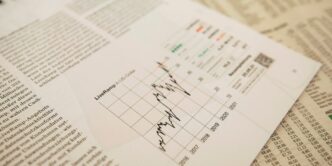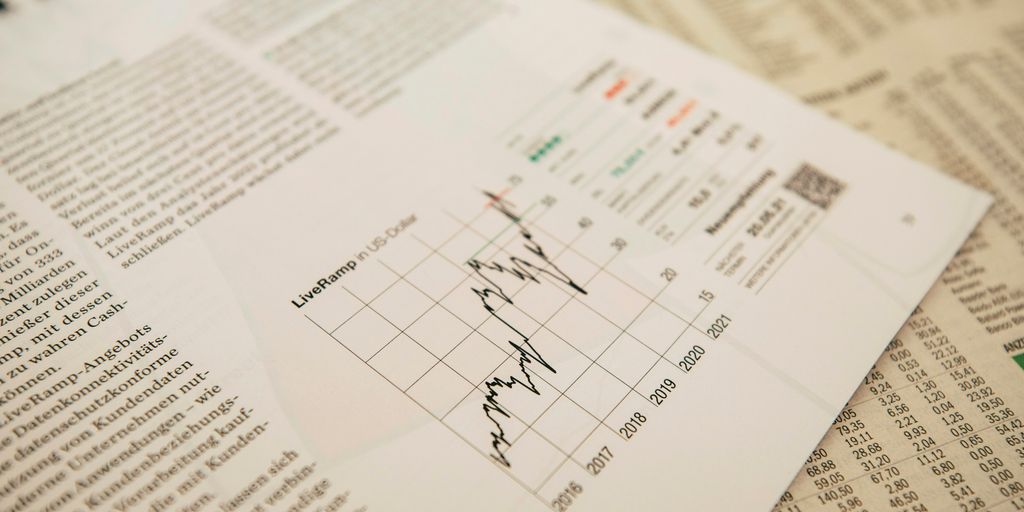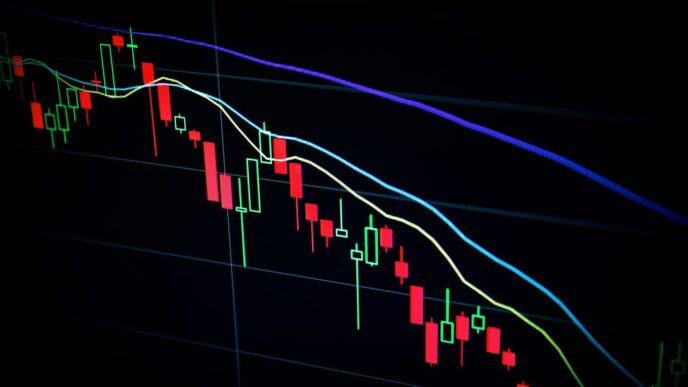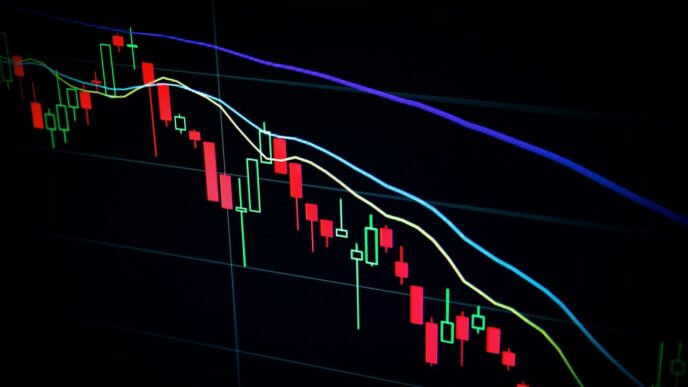The 10 year bond yield might sound like something only financial experts care about, but it actually plays a pretty big role in your everyday money matters. From how much you pay for a mortgage to what your investments do, this number can move things around. Understanding the 10 year bond yield helps you make smarter choices with your money. So, let’s break down what it is and why it matters to you.
Key Takeaways
- The 10 year bond yield is basically the interest rate the U.S. government pays to borrow money for ten years.
- This yield acts like a benchmark for lots of other interest rates, like those for mortgages and other loans.
- Things like inflation expectations, the economy’s health, and what the Federal Reserve does can all make the 10 year bond yield go up or down.
- Changes in the 10 year bond yield can affect how the stock market performs and how much companies are worth.
- Watching the 10 year bond yield can give you clues about how investors feel about the economy and where things might be headed.
Understanding the 10 Year Bond Yield
Defining the 10 Year Treasury Bond Yield
The 10-year Treasury bond yield is basically the interest rate the U.S. government pays when it borrows money for ten years. Think of it as a benchmark. It’s not just some random number; it’s a key indicator of what investors think about the economy. It reflects the return an investor will get if they hold the bond for ten years, assuming the government doesn’t default. The bond’s open price can fluctuate based on market conditions.
The Role of the 10 Year Bond in Economic Signals
This bond yield acts like a signal flare for the economy. When the yield goes up, it often means investors are feeling good about economic growth and expect inflation to rise. They demand a higher return to offset that inflation. When it drops, it can signal worry about a slowdown or even a recession. It’s like investors are running for safety, accepting lower returns on government bonds because they’re scared of riskier investments. It’s an economic indicator that provides information about investor confidence.
Investor Confidence and the 10 Year Bond Yield
The 10-year Treasury yield is a barometer of investor confidence. Here’s how it usually works:
- High Confidence: When investors are optimistic, they tend to sell their bonds and invest in stocks or other assets that offer higher potential returns. This selling pressure pushes bond prices down, and yields go up.
- Low Confidence: When investors are nervous, they flock to the safety of government bonds. This increased demand drives bond prices up, and yields fall.
- Market Outlook: The yield provides information about the global market outlook.
Factors Influencing the 10 Year Bond Yield

It’s not magic, but a bunch of things working together that push the 10-year Treasury yield up or down. Let’s break down the main players.
Inflation Expectations and Yield Movements
Inflation is a big deal. When people think prices are going up, they want a higher yield to make up for the fact that their money won’t buy as much in the future. This pushes the 10-year yield higher. If inflation is expected to stay low, yields tend to drop because investors are okay with a smaller return.
Economic Strength and Investor Demand
A strong economy usually means higher yields. When the economy is doing well, investors are more willing to take risks with things like stocks because they think they can get a better return. This lowers the demand for government bonds, and the yields have to go up to attract buyers. On the flip side, if there’s economic uncertainty, people flock to the safety of bonds, driving yields down.
Monetary Policy and the Federal Reserve’s Impact
The Federal Reserve (the Fed) plays a huge role. The Fed uses monetary policy to influence interest rates and manage the economy. When the Fed raises short-term interest rates to fight inflation, the 10-year yield often follows suit. This is because higher short-term rates make longer-term bonds less attractive unless they offer a higher yield. The Fed’s actions are always something to watch if you’re keeping an eye on the financial news and bond market.
Impact on Borrowing Costs and Consumer Loans
Mortgage Rates and the 10 Year Bond Yield
Okay, so here’s the deal. The 10-year Treasury yield is like the big kahuna when it comes to setting mortgage rates. When the 10-year yield goes up, so do mortgage rates, and vice versa. It’s not a perfect one-to-one thing, but it’s a pretty strong relationship. This is because mortgage-backed securities are often benchmarked against the 10-year. So, if you’re thinking about buying a house, keep an eye on that yield! Higher yields mean you’ll be paying more each month. It’s that simple. The mortgage rates are directly affected.
Student Loans and Other Consumer Credit
It’s not just mortgages that feel the pinch. Student loans, car loans, personal loans – they’re all affected, too. A rising 10-year yield generally translates to higher interest rates on these types of credit. This means you’ll be paying more over the life of the loan. For example:
- Credit card rates might creep up.
- The interest on your next car could be higher.
- Refinancing your student loans might not be as attractive.
Basically, anything that involves borrowing money becomes more expensive. It’s something to keep in mind when you’re making big financial decisions. It’s worth checking out the student loans before making any decisions.
Corporate Borrowing and Business Expansion
It’s not just consumers who feel the impact. Businesses also rely on borrowing to fund their operations and expansion plans. When the 10-year yield rises, it becomes more expensive for companies to borrow money. This can have a ripple effect on the economy. For example:
- Companies might delay or cancel expansion projects.
- They might be less likely to hire new employees.
- Innovation could slow down as companies cut back on research and development.
Here’s a quick look at how borrowing costs might change for businesses:
| Scenario | 10-Year Yield | Corporate Borrowing Costs | Business Expansion | Hiring |
|---|---|---|---|---|
| Yield Increase (e.g., 3%) | Higher | More Expensive | Slows Down | Decreases |
| Yield Decrease (e.g., 1%) | Lower | Less Expensive | Increases | Increases |
So, a high 10-year yield can put a damper on business activity, while a lower yield can help stimulate growth. It’s all connected. The business expansion is affected by the 10-year yield.
Influence on Investment Valuations
Stock Market Performance and Rising Yields
Okay, so picture this: the 10-year Treasury yield starts climbing. What happens to your stocks? Well, it’s not always a direct cause-and-effect thing, but rising yields can definitely put pressure on the stock market. Basically, higher yields make bonds more attractive to investors, because they can get a decent return with less risk. This can lead to some investors pulling money out of stocks and putting it into bonds, which can then cause stock prices to drop. It’s all about that risk-reward balance, you know?
Discounting Future Cash Flows of Companies
This is where things get a little technical, but stick with me. When analysts try to figure out what a company is really worth, they often use something called "discounted cash flow" (DCF) analysis. The idea is that a company’s value is based on the future cash it’s expected to generate. But future money isn’t worth as much as money today, so they ‘discount’ it back to the present. The 10-year Treasury yield often plays a role in determining the discount rate. If the yield goes up, the discount rate goes up, and the present value of those future cash flows goes down. This can lead to lower valuations for companies, especially those whose profits are way out in the future. It’s like, ‘Yeah, they might make a ton of money someday, but that someday is further away, so it’s not worth as much right now.’ Understanding interest rates and inflation is key here.
Safety of Government Bonds Versus Riskier Assets
Let’s be real, government bonds are generally seen as pretty safe. I mean, it’s the government, right? (Knock on wood). So, when the 10-year yield is low, investors might be more willing to take risks and put their money into things like stocks, real estate, or even crypto, hoping for higher returns. But when the yield starts to rise, those government bonds suddenly look a lot more appealing. Why risk your money on something volatile when you can get a decent return from something super safe? This "flight to safety" can pull money away from those riskier assets and into bonds, impacting their prices. It’s all about weighing the potential reward against the potential risk. The stock valuations are affected by this.
The 10 Year Bond Yield as an Economic Indicator
Signaling Global Economic Conditions
The 10-year Treasury yield isn’t just some number floating around; it’s a signal flare about what’s happening in the global economy. Think of it as a temperature gauge. A rising yield often suggests that investors are feeling good about economic growth and expect inflation to pick up. They demand higher returns because they see better opportunities elsewhere. On the flip side, a falling yield usually means investors are running for safety, anticipating an economic slowdown or even deflation. It’s like everyone suddenly deciding they’d rather have a guaranteed small return than risk bigger losses. This impacts return on investment (ROI) across the board.
Investor Sentiment and Market Outlook
The 10-year yield is a window into the collective mindset of investors. It reflects their confidence (or lack thereof) in the economy’s future. When investors are optimistic, they tend to sell off bonds, driving yields up. This is because they’re more willing to take risks in assets like stocks. When they’re pessimistic, they pile into bonds, pushing yields down. It’s a pretty direct read on whether people are feeling bullish or bearish. The bond yield changes can be subtle, but even small movements can signal big shifts in market sentiment.
The Yield Curve and Economic Growth Concerns
The yield curve, which plots yields of various Treasury securities, is a powerful predictor of economic health. Typically, the yield curve slopes upward, meaning longer-term bonds have higher yields than shorter-term ones. This makes sense because investors demand more compensation for tying up their money for longer periods. However, when the yield curve flattens or inverts (short-term yields exceed long-term yields), it’s often a warning sign of a potential recession. An inverted yield curve suggests that investors expect short-term interest rates to fall in the future, which usually happens when the Federal Reserve cuts rates to stimulate a slowing economy. Keep an eye on economic indicator trends.
Here’s a simplified example:
| Bond Type | Typical Yield | Inverted Yield (Example) |
|---|---|---|
| 3-Month Treasury | 1.5% | 2.0% |
| 10-Year Treasury | 2.0% | 1.5% |
When the 3-Month Treasury yield is higher than the 10-Year Treasury yield, that’s an inversion, and historically, it’s been a pretty reliable recession indicator. It’s not a perfect predictor, but it’s something economists and investors watch closely. The 10-year Treasury is a key benchmark.
Historical Context of the 10 Year Bond Yield

Analyzing Past Yield Trends
Looking back at how the 10-year Treasury yield has moved over time can give us some perspective. It’s easy to get caught up in the day-to-day fluctuations, but stepping back to see the bigger picture can be really helpful. The 10-year yield has seen some dramatic shifts, especially when you compare different economic periods.
- During times of economic boom, yields tend to rise as investors shift towards riskier assets.
- Conversely, during recessions, investors often flock to the safety of Treasury bonds, pushing yields down.
- Major events, like the 2008 financial crisis or the COVID-19 pandemic, have caused significant volatility in yields.
Significance of Basis Point Movements
While a small change in the 10-year yield might seem insignificant, even tiny movements can have a big impact. A basis point is just 0.01%, but these little changes add up. For example, a 25 basis point movement can affect mortgage rates, corporate borrowing costs, and even stock market valuations. It’s like a ripple effect – a small pebble creates waves that spread throughout the financial system. It’s important to remember that the market reacts to these changes, so even a small move can signal shifts in investor sentiment or economic expectations. Understanding the significance of these seemingly small changes is key to understanding the bond market.
Comparing Current Rates to Historical Data
One of the most useful things you can do is compare where the 10-year yield is today to where it’s been in the past. This can help you get a sense of whether current rates are high, low, or somewhere in the middle. It’s not about predicting the future, but more about understanding the context. You can easily find historical data on the U.S. Treasury website.
Here’s a simplified example of how you might compare current rates:
| Time Period | Average 10-Year Yield | Notes |
|---|---|---|
| 1980s | 10-12% | High inflation era |
| Early 2000s | 4-6% | Dot-com bubble burst, followed by housing boom |
| Post-2008 Crisis | 2-4% | Quantitative easing, low interest rate environment |
| Today (7/1/2025) | (Hypothetical) 3.5% | Consider current economic conditions (inflation, growth, etc.) |
Protecting Your Investments from Yield Fluctuations
Interest rate changes can feel like a rollercoaster for your investments. The 10-year Treasury yield, in particular, can have a big impact. But don’t worry, there are ways to build resilience and protect your portfolio from these ups and downs. It’s all about understanding the risks and taking steps to manage them.
Diversifying Your Investment Portfolio
Don’t put all your eggs in one basket! Diversification is key. Spreading your investments across different asset classes can help cushion the blow when yields fluctuate. Think about it: if bond yields rise, your bond values might decrease, but your stocks or real estate could perform well, offsetting the losses. It’s about finding the right mix that matches your risk tolerance and financial goals.
Here’s a simple example:
- Stocks: A mix of large-cap, small-cap, and international stocks.
- Bonds: Government bonds, corporate bonds, and maybe even some high-yield bonds (but be careful with those!).
- Real Estate: REITs or direct property ownership.
- Commodities: Gold, silver, or other precious metals.
Understanding Interest Rate Risk
Interest rate risk is the chance that changes in interest rates will negatively affect the value of your investments. When interest rates go up, bond prices usually go down, and vice versa. This is because new bonds are issued with higher yields, making older bonds with lower yields less attractive. The longer the maturity of a bond, the more sensitive it is to interest rate changes. So, a 30-year bond will fluctuate more than a 2-year bond when rates move.
Strategies for Navigating Changing Yields
Okay, so how do you actually do this? Here are a few strategies to consider:
- Laddering Bonds: Instead of buying a single bond with a long maturity, create a bond ladder. This means buying bonds with staggered maturities (e.g., 1-year, 3-year, 5-year). As each bond matures, you reinvest the proceeds into a new bond with a longer maturity. This helps to smooth out the impact of interest rate changes.
- Using Bond ETFs or Mutual Funds: These funds offer instant diversification and professional management. However, be aware of the fund’s duration, which is a measure of its sensitivity to interest rate changes. A fund with a shorter duration will be less affected by rising rates.
- Considering Floating Rate Bonds: These bonds have interest rates that adjust periodically based on a benchmark rate. This means their yields will increase when interest rates rise, providing some protection against inflation and rising yields.
- Rebalancing Your Portfolio: Regularly review your asset allocation and rebalance your portfolio to maintain your desired risk level. If bonds have decreased in value due to rising yields, you might need to sell some other assets and buy more bonds to bring your portfolio back into balance.
It’s not about predicting the future (because nobody can!), it’s about being prepared for different scenarios and having a plan in place to navigate bond market volatility.
Conclusion
So, what does all this mean for you and your money? Well, the 10-year bond yield is a pretty big deal. It’s like a quiet signal that tells us a lot about how the economy is doing and where things might be headed. Keeping an eye on it can help you make smarter choices with your investments, whether you’re thinking about buying a house, saving for retirement, or just trying to understand the daily news. It’s not about panicking every time the numbers move, but more about understanding the bigger picture. Knowing how this one number works can really help you feel more in control of your financial future.
Frequently Asked Questions
What is the 10-year Treasury bond yield?
The 10-year Treasury bond yield is like the interest rate the U.S. government pays when it borrows money for ten years. It’s a really important number because it tells us how confident investors are about the economy and it influences many other interest rates.
What makes the 10-year bond yield change?
Lots of things! If people think prices will go up (inflation), the yield tends to rise. Also, when the economy is doing well, investors might want higher yields. The Federal Reserve’s decisions about interest rates also play a big part.
How does the 10-year bond yield affect my loans?
Yes, it does! When the 10-year yield goes up, things like mortgage rates usually follow. This means it costs more to borrow money for a house, a car, or even student loans. It also affects how much businesses pay to borrow money.
Does the 10-year bond yield affect the stock market?
It can definitely impact stocks. When the yield goes up, bonds become more attractive compared to stocks, and it can make company values seem lower. When the yield goes down, borrowing is cheaper for companies, which can be good for their stock prices.
Why is the 10-year bond yield called an ‘economic indicator’?
Think of it as a report card for the economy. A rising yield can mean people are feeling good about the economy, while a falling yield might suggest they’re worried. It’s a way to see what big investors are thinking.
How can I protect my investments from changes in the 10-year bond yield?
You can protect your money by not putting all your eggs in one basket – spread your investments around! Also, understand that interest rates can go up and down, so it’s good to have a plan for different situations.














